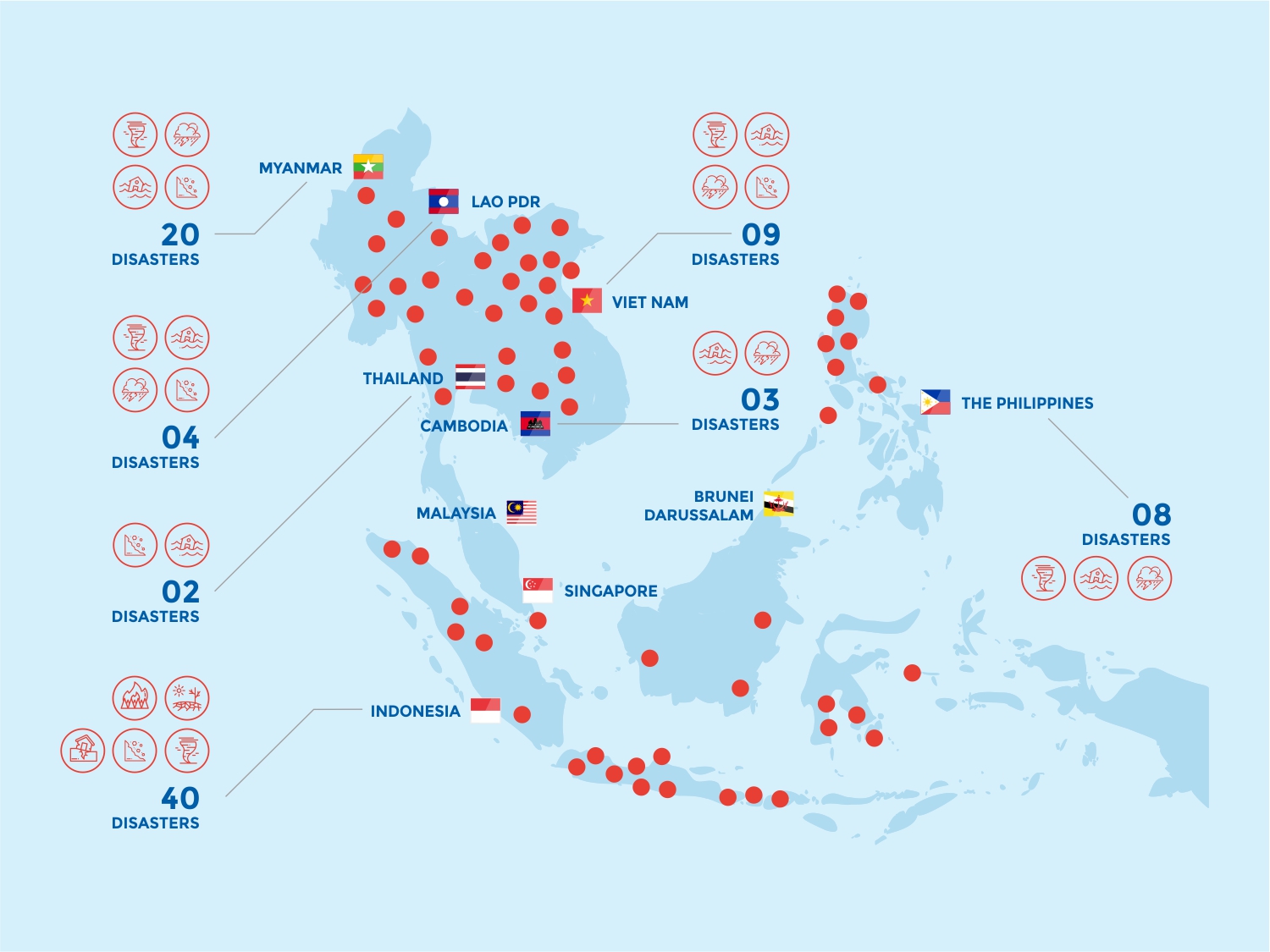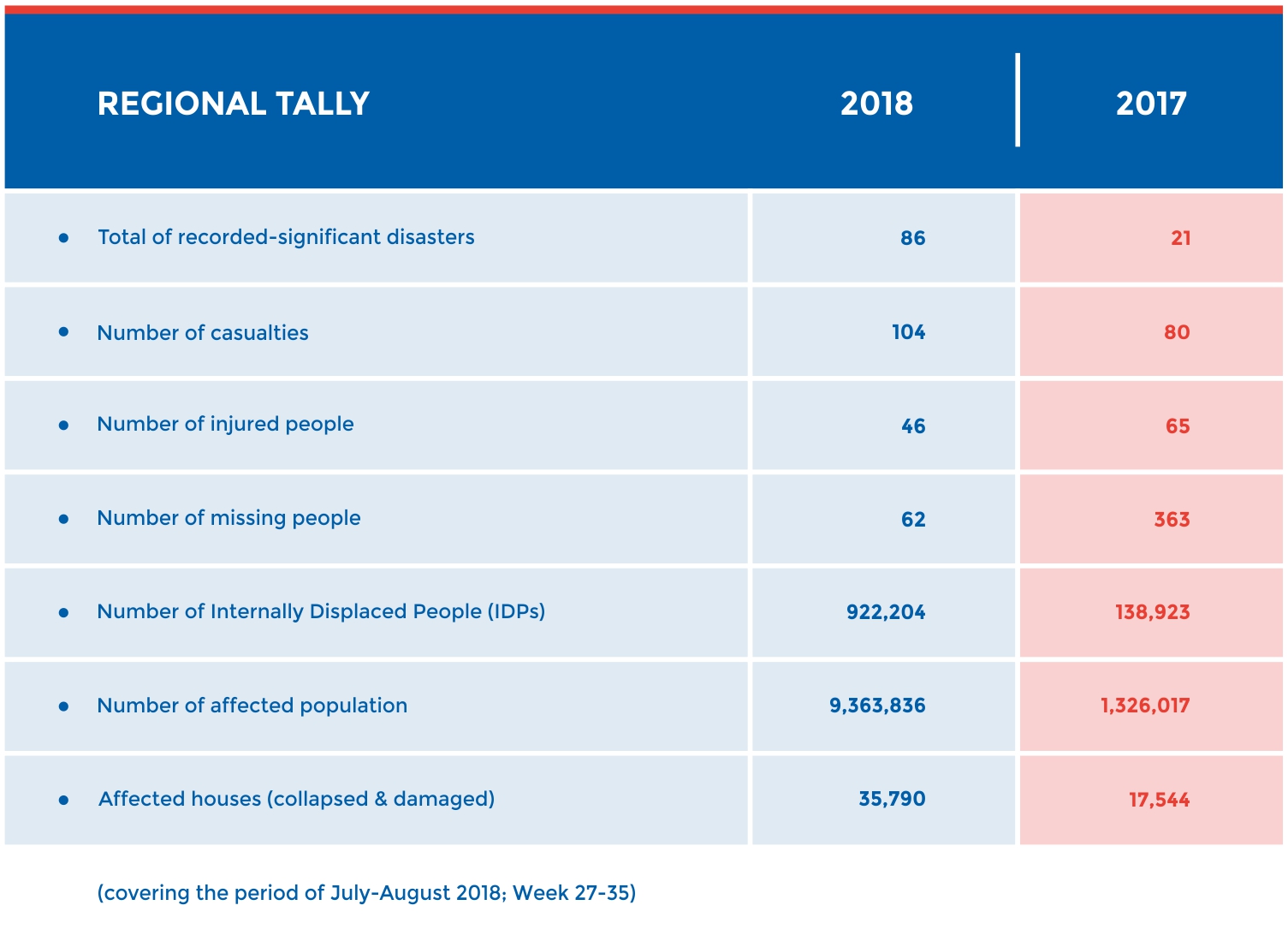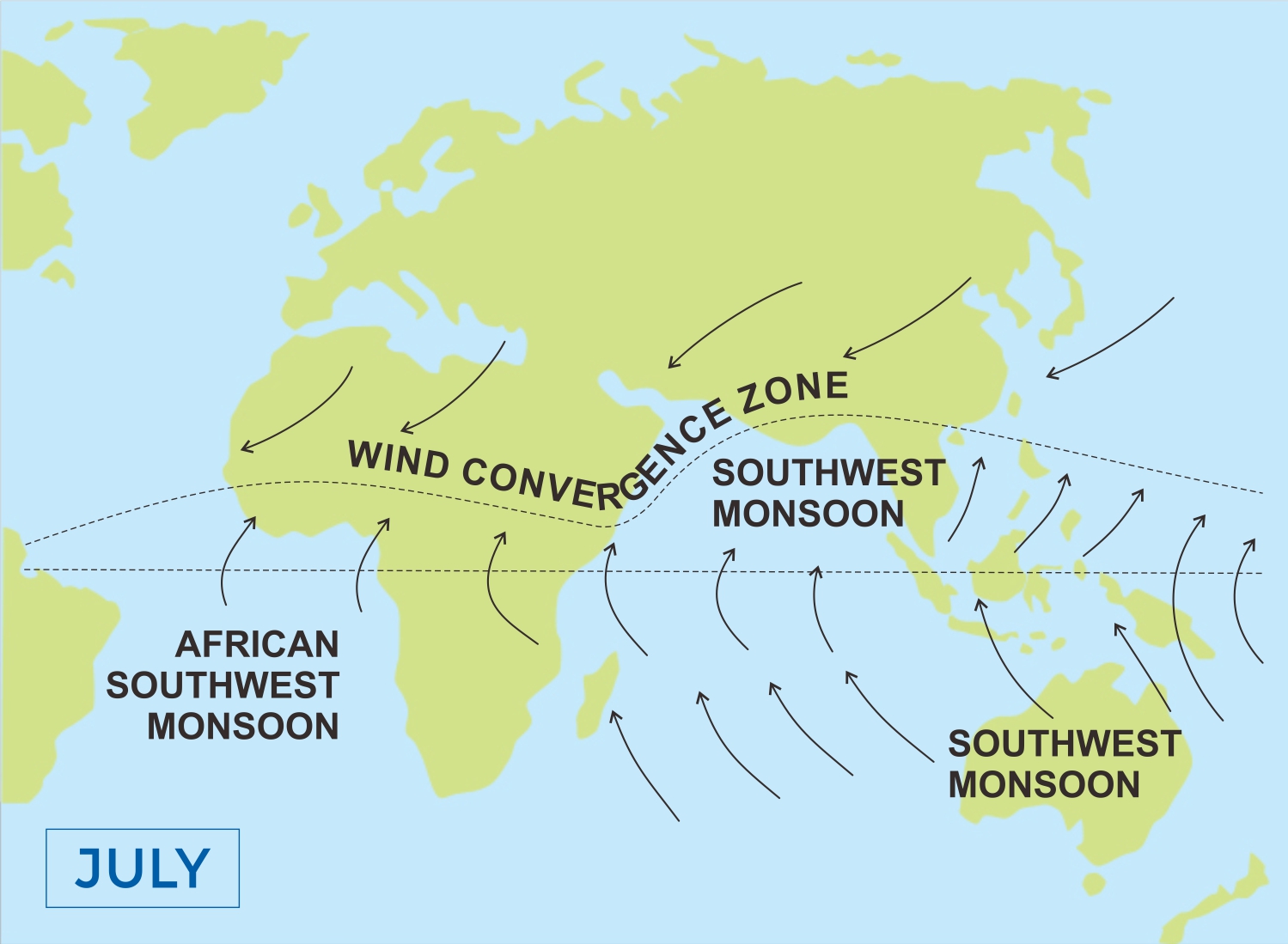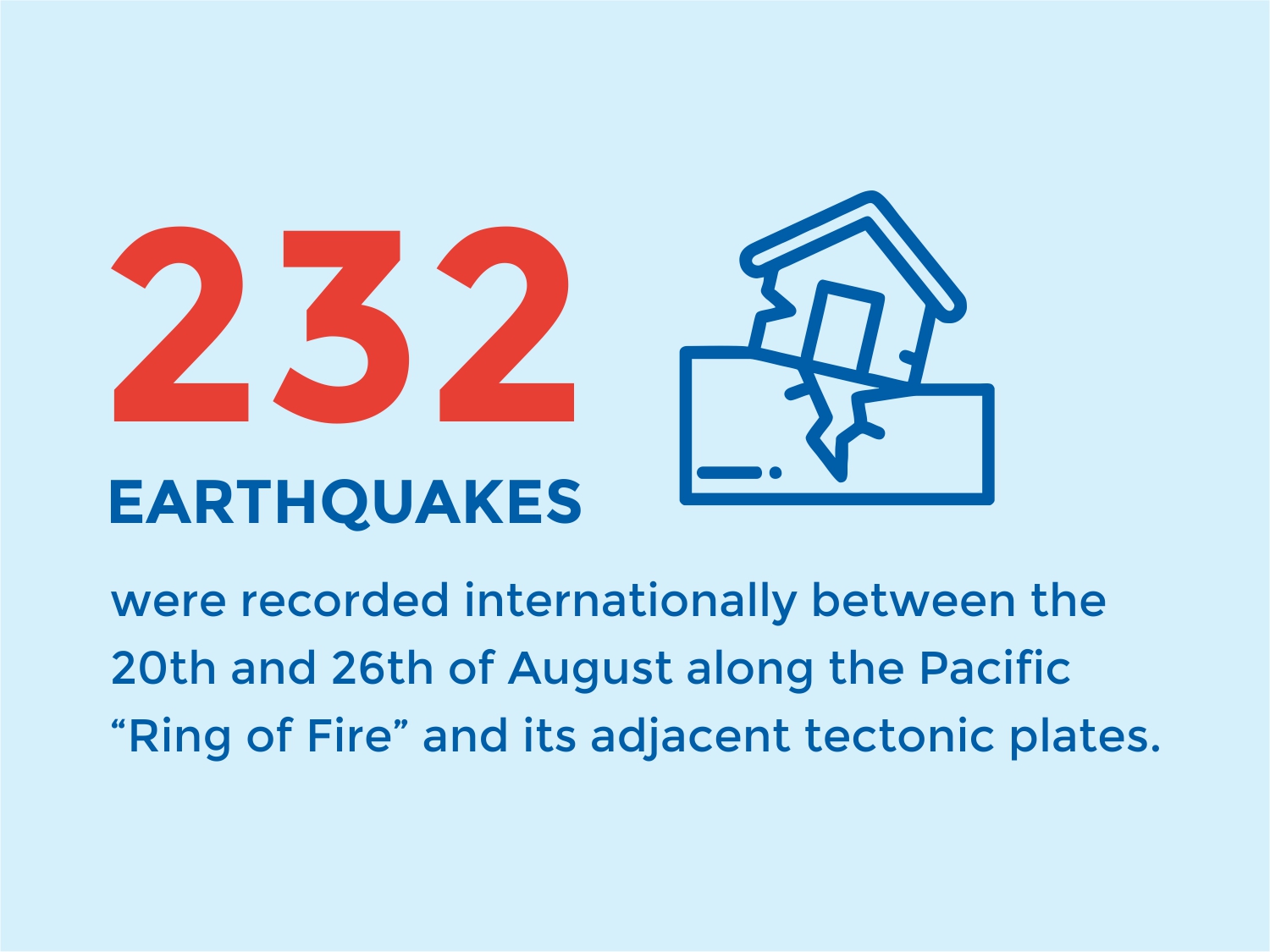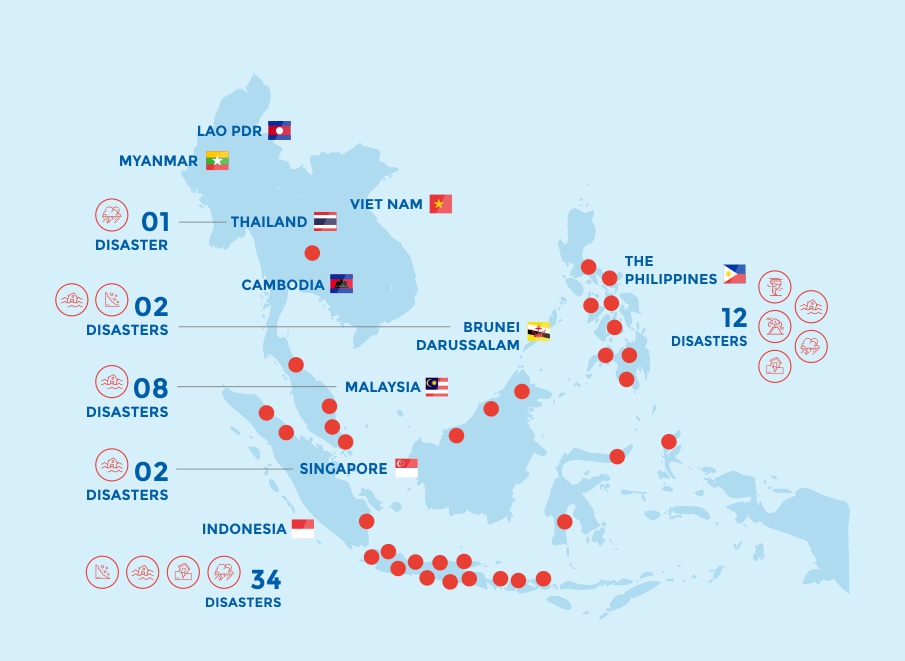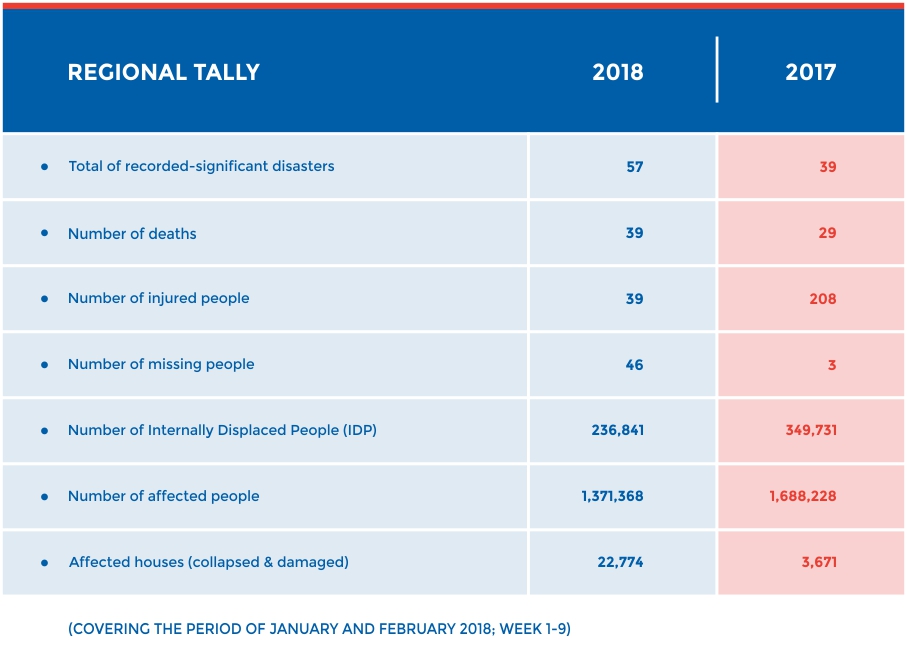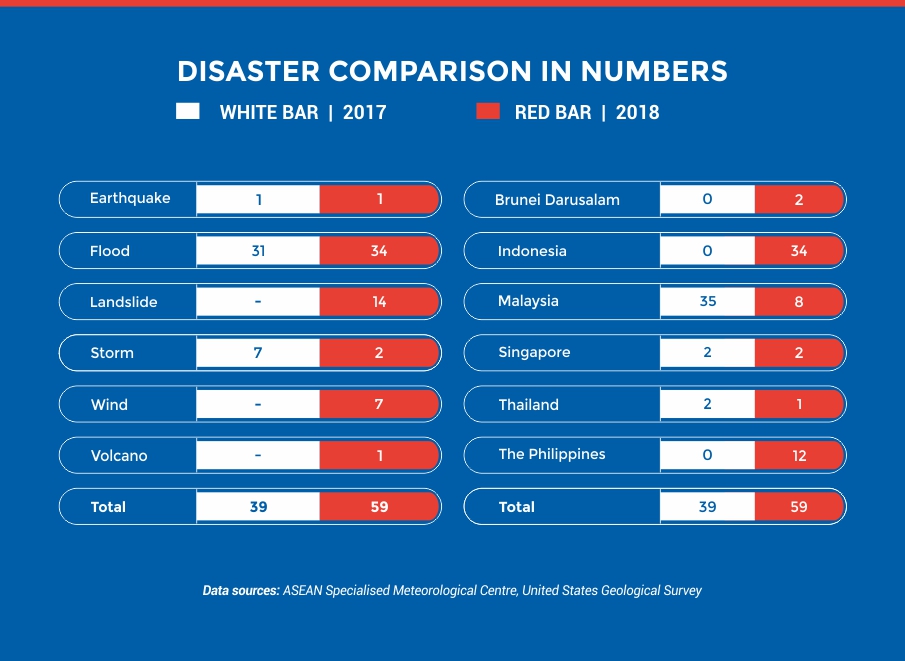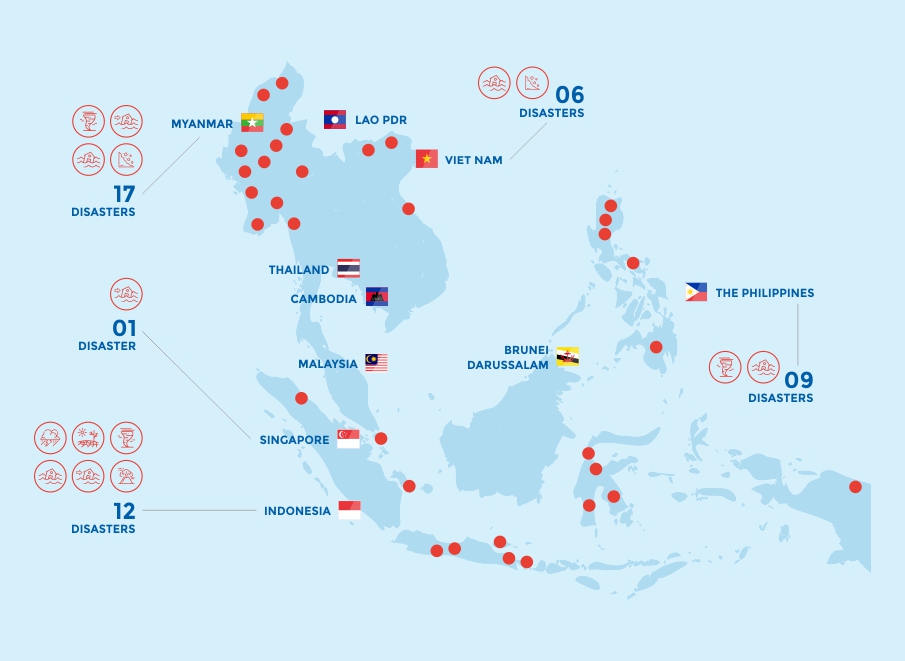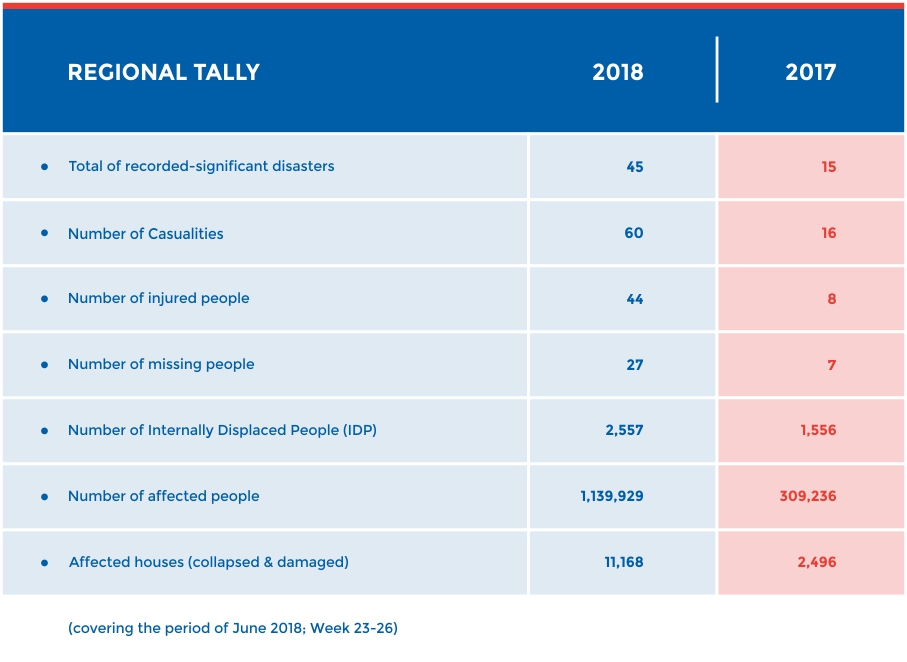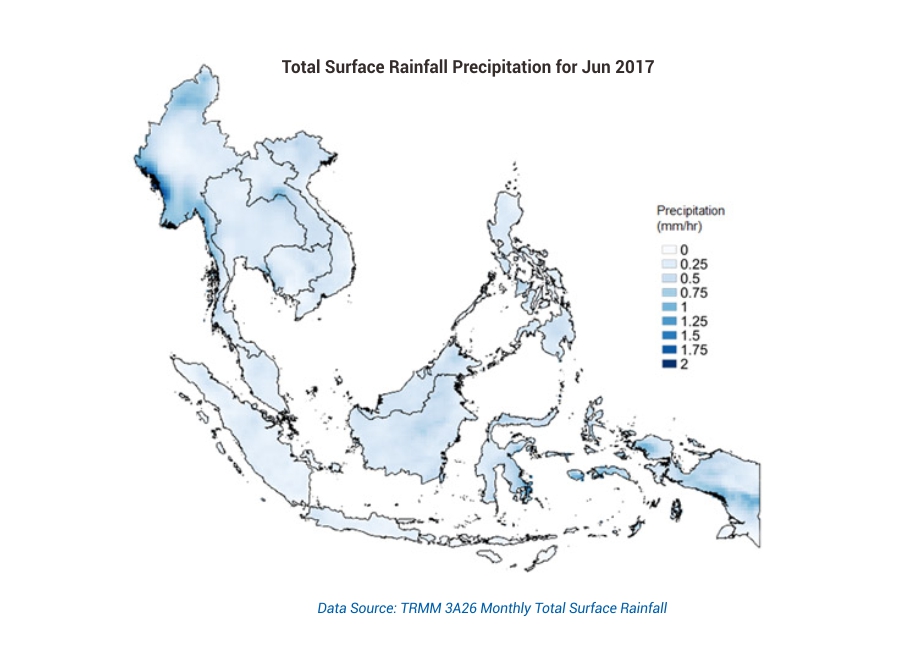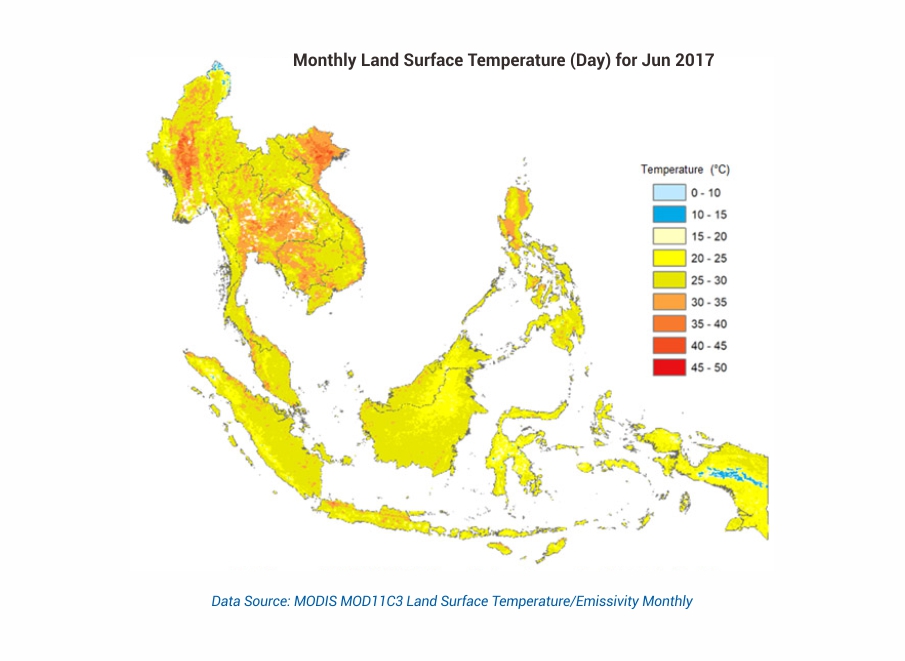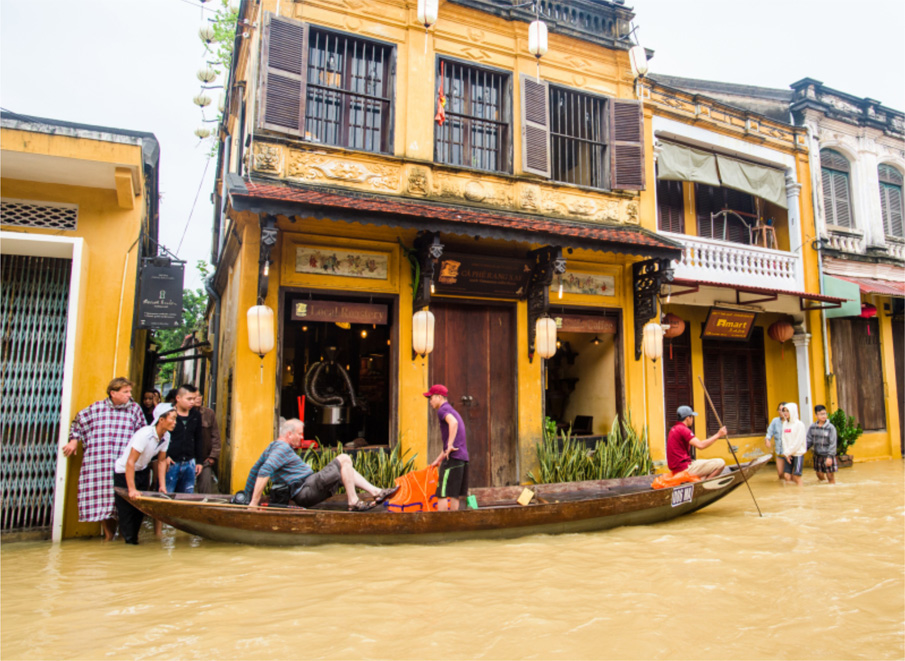Vol 42-Monthly Disaster Review and Outlook

MONTHLY DISASTER REVIEW AND OUTLOOK
JULY & AUGUST | DISASTER MONITORING & ANALYSIS
(DMA) UNIT, AHA CENTRE
GENERAL OVERVIEW OF JULY AND AUGUST 2018
A two-week period in July saw the development of 5 tropical storms, one of which had a severe affect on the northern ASEAN region. The Southwest monsoon (refer to figure 1.) brought with it heavy torrential rains, resulting in flooding through the Mekong River region. Hydro-meteorological disasters formed the main hazards during this period, and are expected to persist with continued rain over the northern ASEAN region, coupled with drier conditions in southern part of ASEAN.
In contrast to the situation in the northern ASEAN region, droughts in 16 municipalities have been reported across seven consecutive weeks thus far, with one reported wildfire occurrence in the past month. The ASEAN Specialised Meteorological Centre detected hotspots in Indonesia’s Kalimantan and Sumatra during July. General conditions for August remained similar to July, with high rainfall experienced over the northern region, impacting countries in the Mekong region and northern parts of the Philippines.
Throughout the last 2 months, large numbers of earthquakes were recorded and experienced by ASEAN communities. The increased seismic activity is not only restricted to the region,with the phenomenon also seen globally. A total of 232 earthquakes were recorded internationally between the 20th and 26th of August along the Pacific “Ring of Fire” and its adjacent tectonic plates. Of these recorded earthquakes, 37 (15.9%) were recorded at a scale of M 5.0 or above, with 25 (67.6%) of these major earthquakes (≥M 5.0) occurring within a span of 48 hours between August 20th to 22nd. Of these 232 earthquakes, 32 (13.8%) were reported within the ASEAN region. Of the 32 recorded in the region, 11 (34.4%) were reported to be M 5.0 and above. The increasing seismic activity is currently being observed by seismological agencies in anticipation of increased volcanic activity, earthquakes, tsunamis and other related hazards. Nevertheless, in July and August 2018, activity of volcanoes in Philippines and Indonesia stayed within their normal threshold, with no changes in any of their alert levels
The prevailing Southwest Monsoon season is expected to persist until October 2018, with prevailing winds in the region blowing from the southeast or southwest. Climatologically, the Southwest Monsoon season is characterised by rainy conditions in the northern ASEAN region, and dry conditions in the southern ASEAN region.
OUTLOOK FOR AUGUST-OCTOBER 2018
Warmer than average conditions can be expected over the equatorial ASEAN region, especially in Borneo and south-eastern Sumatra, while near-average or slightly above-average temperatures are forecasted over most other areas during the August-October season.
For the equatorial ASEAN region, below-average rainfall is forecasted between August and October. The drier-than-usual weather could to lead to an escalation in hotspot activities and an increased risk of transboundary smoke haze.
Near-average rainfall is forecasted for the rest of the region, including the northern ASEAN region. Hotspot activities in the northern ASEAN region are likely to remain subdued due to wet weather. The outlook is assessed for the region in general. For specific updates on the national scale, the relevant National Meteorological and Hydrological Services as well as Geological Services should be consulted.
Written by : Mizan Bisri, Qing Yuan Pang
DISCLAIMER
AHA Centre’s estimation is based on data and information shared by National Disaster Management Organisations (NDMOs) and other relevant agencies from ASEAN Member States, international organisations and news agencies. Further information on each recorded-significant disaster, description and details of data and information are available at: http://adinet.ahacentre.org/reports.
- Published in Monthly Disaster Outlook
Vol 36-Monthly Disaster Outlook

MONTHLY DISASTER REVIEW OUTLOOK
JANUARY AND FEBRUARY 2018 | DISASTER MONITORING & ANALYSIS
(DMA) UNIT, AHA CENTRE
GENERAL OVERVIEW OF JAN AND FEB 2018
Between January and February 2018, a total of 57 disasters were reported from within ASEAN Member States. Due to the higher-than-average rainfall; 57.8% of all disasters reported in this period are attributed to floods. In addition, landslides are of major concern in areas prone to slope failure which potentially cause disruptions and significant damage to major circulatory transport systems, as well as impacting communities and trade. In the northern ASEAN region, record-low temperatures have been reported during this winter season, with storms recorded in Viet Nam, Thailand and Cambodia. Whereas the emergency response operation for Typhoon Tembin was extended until the third week of January, additional impact of Tropical Storm Sanba (Basyang) affected more than two hundred-thousand people in the Philippines.
Earthquakes and volcanic activity remain high on the agenda, with two significant earthquakes observed in the region. A magnitude 6.1 earthquake occurred on the 23rd of January 2018, affecting provinces of Banten, West Java and Jakarta in Indonesia. Although there were over seven thousand homes damaged, the emergency response was managed well by the Indonesian authorities. More recently, a magnitude 7.6 earthquake was recorded in Papua New Guinea on February 26th, with tremors felt and light damage caused in several regencies of the Papua Province (Indonesia). The earthquake was followed by 53 strong aftershocks (M 5.0 and above) within the following week, without additional damage experienced in any parts of Indonesia. Also in Indonesia, the situation on Mount Agung, Bali, has greatly improved, with its alert level being lowered, and its mandatory exclusion zone relaxed. In the Philippines, Mount Mayon’s Phreatomagmatic Eruption, has been ongoing throughout January & February. This activity has affected the daily lives of more than 90,000 people in the Albay Province, yet there have been no human casualties reported, showcasing the result of effective preparedness and response.
OUTLOOK FOR MARCH AND APRIL 2018
ASEAN Specialised Meteorological Centre (ASMC) has forecasted that during the coming months, the region will begin a gradual transition from the current Northeast Monsoon season to the inter-monsoon period. The inter-monsoon period (April and May) is a transition period that sees low-level winds in the region being generally light and variable in direction, with an increase in light rain activity expected across ASEAN during this time.
For the March-April-May 2018 season, slightly below-average to near-average rainfall is forecasted for most parts of Southeast Asia, except for the Philippines, who can expect slightly above-average rainfall during these months. During March and April, slightly above-normal rainfall is forecasted over the northern parts of Kalimantan and Sulawesi, as well as the western districts of Papua.
Written by : Mizan Bisri, Qing Yuan Pang
DISCLAIMER
AHA Centre’s estimation is based on data and information shared by National Disaster Management Organisations (NDMOs) and other relevant agencies from ASEAN Member States, international organisations and news agencies. Further information on each recorded-significant disaster, description and details of data and information are available at: http://adinet.ahacentre.org/reports.
- Published in Monthly Disaster Outlook
Vol 40-Monthly Disaster Review and Outlook

MONTHLY DISASTER REVIEW AND OUTLOOK
JUNE 2018 | DISASTER MONITORING & ANALYSIS
(DMA) UNIT, AHA CENTRE
GENERAL OVERVIEW OF JUNE 2018
There was a three-fold increase in the number of disasters recorded during June 2018 (45 in total) in comparison to the same time during 2017 (15 disasters). An onset of numerous weather events caused this spike in disasters, with the southwest monsoons, Tropical Depression (TD) Domeng, TD Ewiniar, TD Ester and TS Florita causing floods and landslides throughout the Philippines, Viet Nam and Myanmar. In contrast, several areas south of the equator, particularly Indonesia’s Central Java and Yogyakarta provinces, have experienced the onset of drought conditions, consistent with the shift to the region’s dry season. This such phenomena indicates a similar pattern to 2017, which saw northern parts of ASEAN experiencing wet season floods, while southern parts experienced dry season drought events (see Figure 1) . Overall, 20 flood events, 11 storms and 4 wind-related disasters were recorded throughout June 2018.
In terms of geological hazards, 26 earthquakes registering ≥ M 4.5 were observed across Indonesia and the Philippines. However, only two were strong enough to cause property damage (East Java and Papua provinces of Indonesia, on the 13th and 15th of June respectively. Towards the end of June 2018, concerns were raised due to increased activity reported on Bali’s Mount Agung, which released ash plumes and resulted in a strombolian-type eruption.
OUTLOOK FOR JULY-AUGUST 2018
According to the ASEAN Specialised Meteorological Centre (ASMC), most parts of the ASEAN region will continue to experience wet weather, as the rain band associated with Typhoon Prapiroon affects the region. Hotspot activities have remained subdued, but isolated events have been detected in Viet Nam and Lao PDR. During the first week of July, dry weather is expected to affect Java, and may exacerbate the ongoing drought events. Aside from such southern areas, wet weather is likely to persist over other parts of the ASEAN region. For tropical cyclone (TC) forecasts, the Philippine Atmospheric. Geophysical and Astronomical Services Administration (PAGASA) expects that 10-14 TCs will form and enter the Philippine Area of Responsibility throughout the six months between July and December 2018.
Close and continuous monitoring is still required for Mount Sinabung (Alert Level IV) and Mount Agung (Alert Level III) in Indonesia, particularly due to historic Mount Agung eruptions, which lasted up to one year during 1963-1964.
Written by : Mizan Bisri, Qing Yuan Pang
DISCLAIMER
AHA Centre’s estimation is based on data and information shared by National Disaster Management Organisations (NDMOs) and other relevant agencies from ASEAN Member States, international organisations and news agencies. Further information on each recorded-significant disaster, description and details of data and information are available at: http://adinet.ahacentre.org/reports.
- Published in Monthly Disaster Outlook

